Clinical Reflective Essay
VerifiedAdded on 2023/01/10
|14
|4194
|61
AI Summary
This clinical reflective essay explores the importance of reflection in nursing profession and professional development. It discusses the NMC standards for inter-professional working and utilizes the Gibbs model of reflection to analyze a case scenario. The essay highlights the emotions, evaluation, analysis, conclusion, and action plan in the reflection process.
Contribute Materials
Your contribution can guide someone’s learning journey. Share your
documents today.
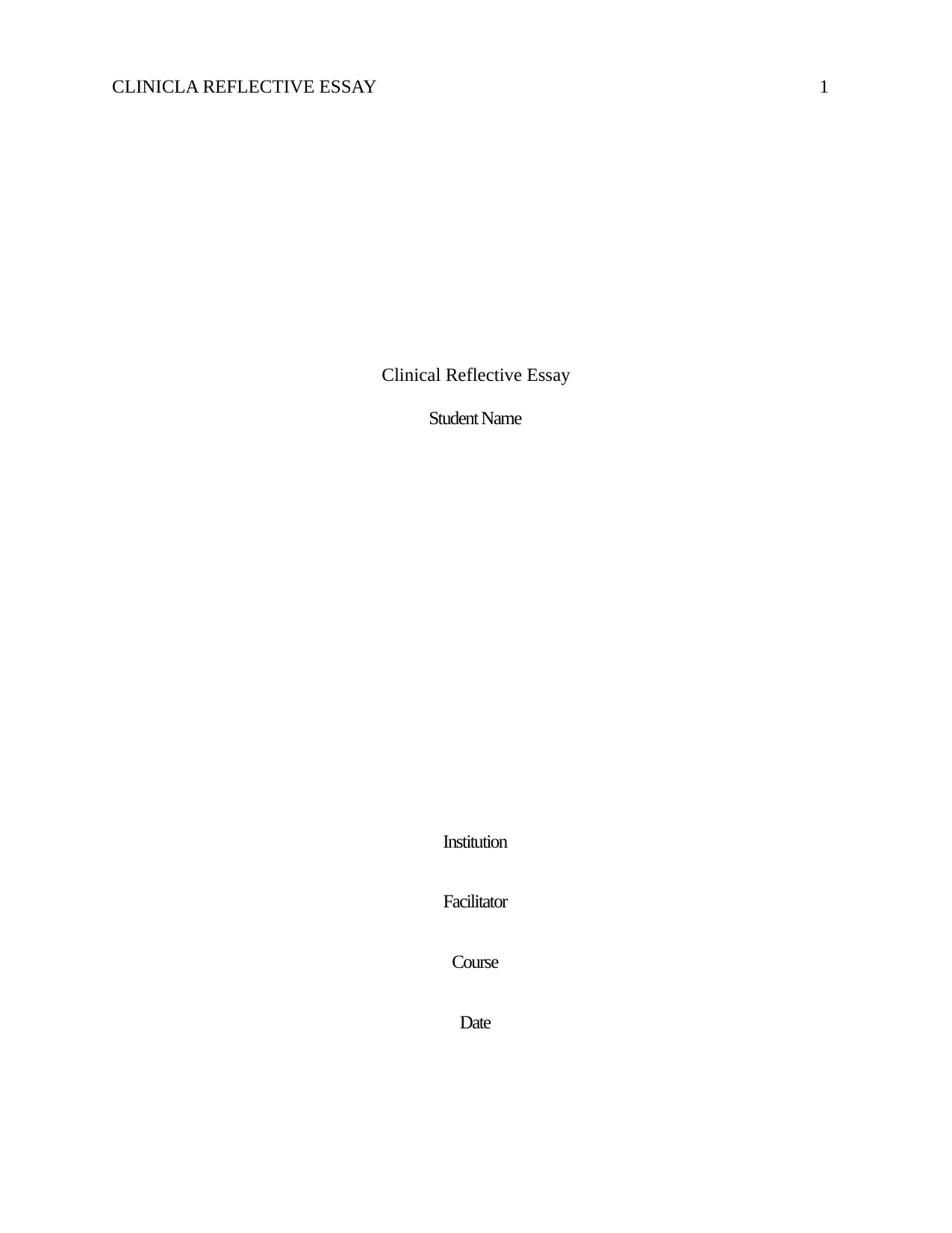
CLINICLA REFLECTIVE ESSAY 1
Clinical Reflective Essay
Student Name
Institution
Facilitator
Course
Date
Clinical Reflective Essay
Student Name
Institution
Facilitator
Course
Date
Secure Best Marks with AI Grader
Need help grading? Try our AI Grader for instant feedback on your assignments.
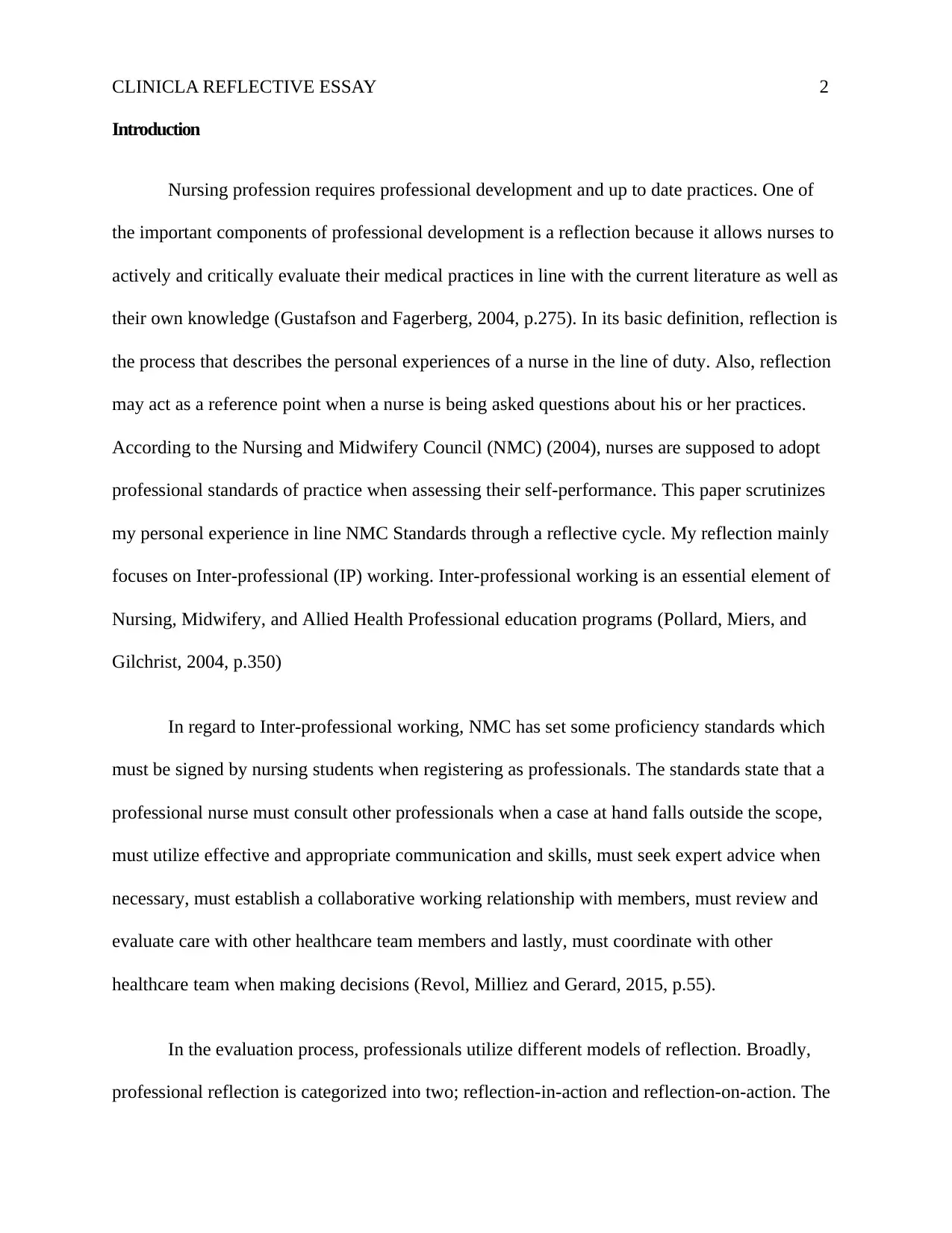
CLINICLA REFLECTIVE ESSAY 2
Introduction
Nursing profession requires professional development and up to date practices. One of
the important components of professional development is a reflection because it allows nurses to
actively and critically evaluate their medical practices in line with the current literature as well as
their own knowledge (Gustafson and Fagerberg, 2004, p.275). In its basic definition, reflection is
the process that describes the personal experiences of a nurse in the line of duty. Also, reflection
may act as a reference point when a nurse is being asked questions about his or her practices.
According to the Nursing and Midwifery Council (NMC) (2004), nurses are supposed to adopt
professional standards of practice when assessing their self-performance. This paper scrutinizes
my personal experience in line NMC Standards through a reflective cycle. My reflection mainly
focuses on Inter-professional (IP) working. Inter-professional working is an essential element of
Nursing, Midwifery, and Allied Health Professional education programs (Pollard, Miers, and
Gilchrist, 2004, p.350)
In regard to Inter-professional working, NMC has set some proficiency standards which
must be signed by nursing students when registering as professionals. The standards state that a
professional nurse must consult other professionals when a case at hand falls outside the scope,
must utilize effective and appropriate communication and skills, must seek expert advice when
necessary, must establish a collaborative working relationship with members, must review and
evaluate care with other healthcare team members and lastly, must coordinate with other
healthcare team when making decisions (Revol, Milliez and Gerard, 2015, p.55).
In the evaluation process, professionals utilize different models of reflection. Broadly,
professional reflection is categorized into two; reflection-in-action and reflection-on-action. The
Introduction
Nursing profession requires professional development and up to date practices. One of
the important components of professional development is a reflection because it allows nurses to
actively and critically evaluate their medical practices in line with the current literature as well as
their own knowledge (Gustafson and Fagerberg, 2004, p.275). In its basic definition, reflection is
the process that describes the personal experiences of a nurse in the line of duty. Also, reflection
may act as a reference point when a nurse is being asked questions about his or her practices.
According to the Nursing and Midwifery Council (NMC) (2004), nurses are supposed to adopt
professional standards of practice when assessing their self-performance. This paper scrutinizes
my personal experience in line NMC Standards through a reflective cycle. My reflection mainly
focuses on Inter-professional (IP) working. Inter-professional working is an essential element of
Nursing, Midwifery, and Allied Health Professional education programs (Pollard, Miers, and
Gilchrist, 2004, p.350)
In regard to Inter-professional working, NMC has set some proficiency standards which
must be signed by nursing students when registering as professionals. The standards state that a
professional nurse must consult other professionals when a case at hand falls outside the scope,
must utilize effective and appropriate communication and skills, must seek expert advice when
necessary, must establish a collaborative working relationship with members, must review and
evaluate care with other healthcare team members and lastly, must coordinate with other
healthcare team when making decisions (Revol, Milliez and Gerard, 2015, p.55).
In the evaluation process, professionals utilize different models of reflection. Broadly,
professional reflection is categorized into two; reflection-in-action and reflection-on-action. The
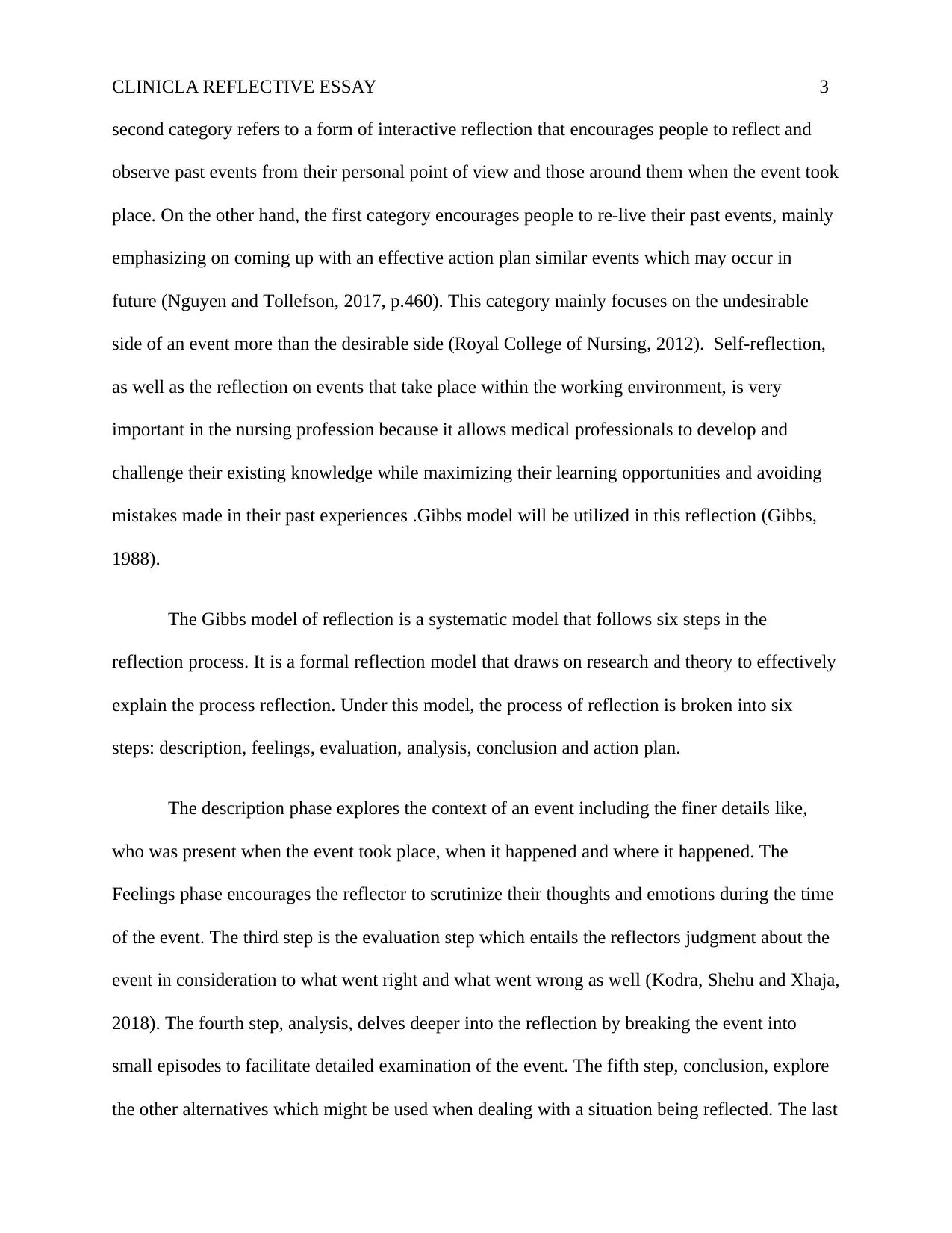
CLINICLA REFLECTIVE ESSAY 3
second category refers to a form of interactive reflection that encourages people to reflect and
observe past events from their personal point of view and those around them when the event took
place. On the other hand, the first category encourages people to re-live their past events, mainly
emphasizing on coming up with an effective action plan similar events which may occur in
future (Nguyen and Tollefson, 2017, p.460). This category mainly focuses on the undesirable
side of an event more than the desirable side (Royal College of Nursing, 2012). Self-reflection,
as well as the reflection on events that take place within the working environment, is very
important in the nursing profession because it allows medical professionals to develop and
challenge their existing knowledge while maximizing their learning opportunities and avoiding
mistakes made in their past experiences .Gibbs model will be utilized in this reflection (Gibbs,
1988).
The Gibbs model of reflection is a systematic model that follows six steps in the
reflection process. It is a formal reflection model that draws on research and theory to effectively
explain the process reflection. Under this model, the process of reflection is broken into six
steps: description, feelings, evaluation, analysis, conclusion and action plan.
The description phase explores the context of an event including the finer details like,
who was present when the event took place, when it happened and where it happened. The
Feelings phase encourages the reflector to scrutinize their thoughts and emotions during the time
of the event. The third step is the evaluation step which entails the reflectors judgment about the
event in consideration to what went right and what went wrong as well (Kodra, Shehu and Xhaja,
2018). The fourth step, analysis, delves deeper into the reflection by breaking the event into
small episodes to facilitate detailed examination of the event. The fifth step, conclusion, explore
the other alternatives which might be used when dealing with a situation being reflected. The last
second category refers to a form of interactive reflection that encourages people to reflect and
observe past events from their personal point of view and those around them when the event took
place. On the other hand, the first category encourages people to re-live their past events, mainly
emphasizing on coming up with an effective action plan similar events which may occur in
future (Nguyen and Tollefson, 2017, p.460). This category mainly focuses on the undesirable
side of an event more than the desirable side (Royal College of Nursing, 2012). Self-reflection,
as well as the reflection on events that take place within the working environment, is very
important in the nursing profession because it allows medical professionals to develop and
challenge their existing knowledge while maximizing their learning opportunities and avoiding
mistakes made in their past experiences .Gibbs model will be utilized in this reflection (Gibbs,
1988).
The Gibbs model of reflection is a systematic model that follows six steps in the
reflection process. It is a formal reflection model that draws on research and theory to effectively
explain the process reflection. Under this model, the process of reflection is broken into six
steps: description, feelings, evaluation, analysis, conclusion and action plan.
The description phase explores the context of an event including the finer details like,
who was present when the event took place, when it happened and where it happened. The
Feelings phase encourages the reflector to scrutinize their thoughts and emotions during the time
of the event. The third step is the evaluation step which entails the reflectors judgment about the
event in consideration to what went right and what went wrong as well (Kodra, Shehu and Xhaja,
2018). The fourth step, analysis, delves deeper into the reflection by breaking the event into
small episodes to facilitate detailed examination of the event. The fifth step, conclusion, explore
the other alternatives which might be used when dealing with a situation being reflected. The last
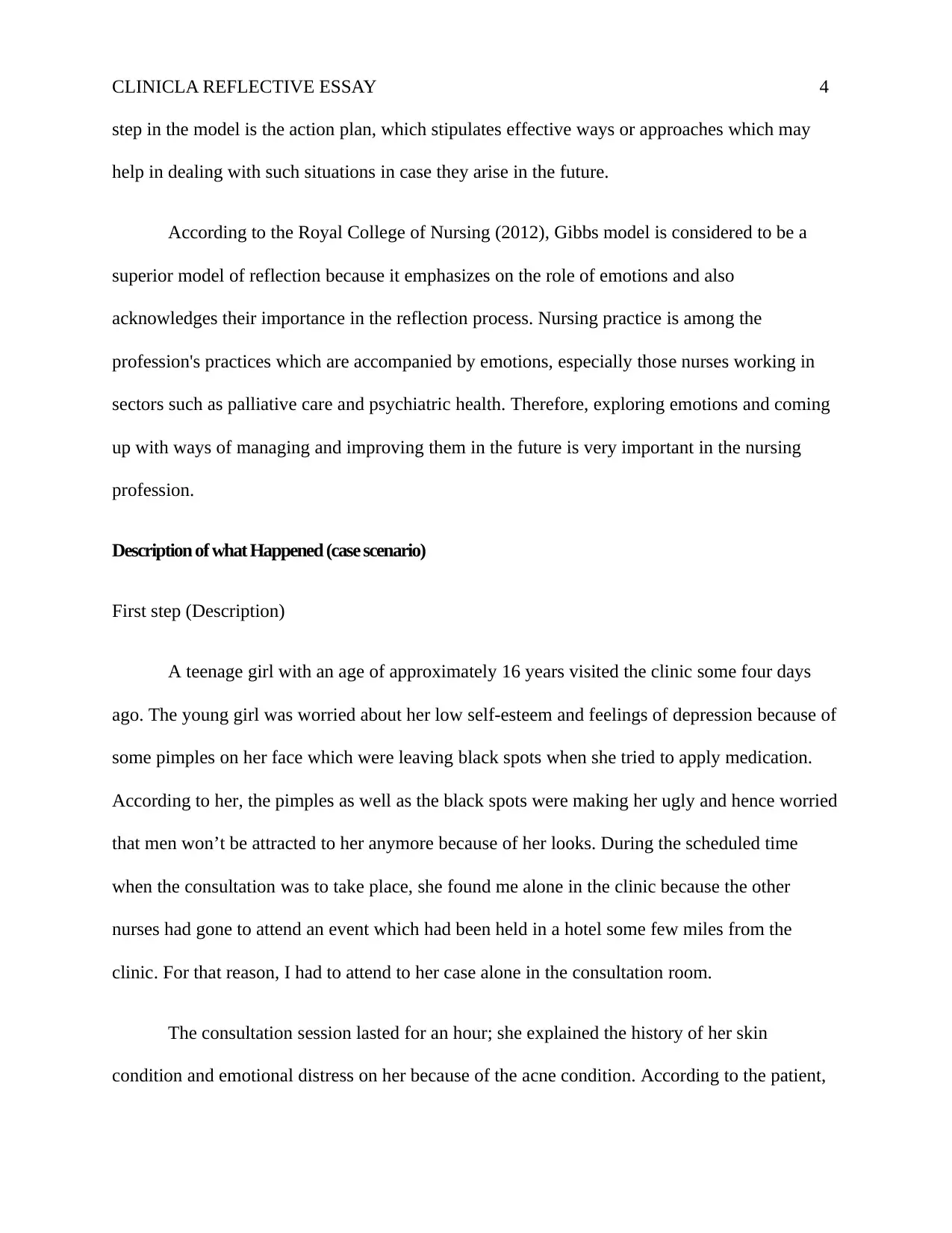
CLINICLA REFLECTIVE ESSAY 4
step in the model is the action plan, which stipulates effective ways or approaches which may
help in dealing with such situations in case they arise in the future.
According to the Royal College of Nursing (2012), Gibbs model is considered to be a
superior model of reflection because it emphasizes on the role of emotions and also
acknowledges their importance in the reflection process. Nursing practice is among the
profession's practices which are accompanied by emotions, especially those nurses working in
sectors such as palliative care and psychiatric health. Therefore, exploring emotions and coming
up with ways of managing and improving them in the future is very important in the nursing
profession.
Description of what Happened (case scenario)
First step (Description)
A teenage girl with an age of approximately 16 years visited the clinic some four days
ago. The young girl was worried about her low self-esteem and feelings of depression because of
some pimples on her face which were leaving black spots when she tried to apply medication.
According to her, the pimples as well as the black spots were making her ugly and hence worried
that men won’t be attracted to her anymore because of her looks. During the scheduled time
when the consultation was to take place, she found me alone in the clinic because the other
nurses had gone to attend an event which had been held in a hotel some few miles from the
clinic. For that reason, I had to attend to her case alone in the consultation room.
The consultation session lasted for an hour; she explained the history of her skin
condition and emotional distress on her because of the acne condition. According to the patient,
step in the model is the action plan, which stipulates effective ways or approaches which may
help in dealing with such situations in case they arise in the future.
According to the Royal College of Nursing (2012), Gibbs model is considered to be a
superior model of reflection because it emphasizes on the role of emotions and also
acknowledges their importance in the reflection process. Nursing practice is among the
profession's practices which are accompanied by emotions, especially those nurses working in
sectors such as palliative care and psychiatric health. Therefore, exploring emotions and coming
up with ways of managing and improving them in the future is very important in the nursing
profession.
Description of what Happened (case scenario)
First step (Description)
A teenage girl with an age of approximately 16 years visited the clinic some four days
ago. The young girl was worried about her low self-esteem and feelings of depression because of
some pimples on her face which were leaving black spots when she tried to apply medication.
According to her, the pimples as well as the black spots were making her ugly and hence worried
that men won’t be attracted to her anymore because of her looks. During the scheduled time
when the consultation was to take place, she found me alone in the clinic because the other
nurses had gone to attend an event which had been held in a hotel some few miles from the
clinic. For that reason, I had to attend to her case alone in the consultation room.
The consultation session lasted for an hour; she explained the history of her skin
condition and emotional distress on her because of the acne condition. According to the patient,
Secure Best Marks with AI Grader
Need help grading? Try our AI Grader for instant feedback on your assignments.
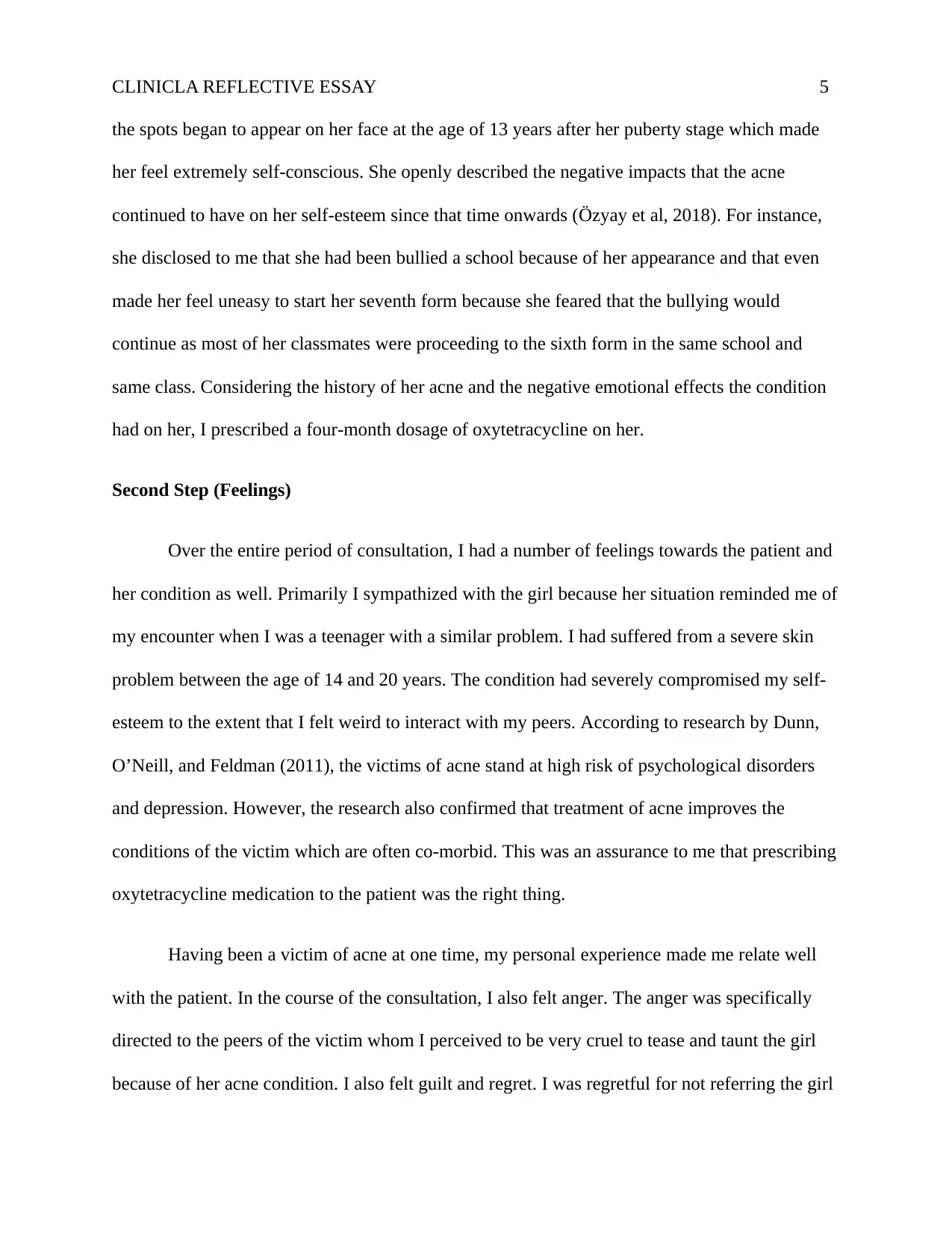
CLINICLA REFLECTIVE ESSAY 5
the spots began to appear on her face at the age of 13 years after her puberty stage which made
her feel extremely self-conscious. She openly described the negative impacts that the acne
continued to have on her self-esteem since that time onwards (Özyay et al, 2018). For instance,
she disclosed to me that she had been bullied a school because of her appearance and that even
made her feel uneasy to start her seventh form because she feared that the bullying would
continue as most of her classmates were proceeding to the sixth form in the same school and
same class. Considering the history of her acne and the negative emotional effects the condition
had on her, I prescribed a four-month dosage of oxytetracycline on her.
Second Step (Feelings)
Over the entire period of consultation, I had a number of feelings towards the patient and
her condition as well. Primarily I sympathized with the girl because her situation reminded me of
my encounter when I was a teenager with a similar problem. I had suffered from a severe skin
problem between the age of 14 and 20 years. The condition had severely compromised my self-
esteem to the extent that I felt weird to interact with my peers. According to research by Dunn,
O’Neill, and Feldman (2011), the victims of acne stand at high risk of psychological disorders
and depression. However, the research also confirmed that treatment of acne improves the
conditions of the victim which are often co-morbid. This was an assurance to me that prescribing
oxytetracycline medication to the patient was the right thing.
Having been a victim of acne at one time, my personal experience made me relate well
with the patient. In the course of the consultation, I also felt anger. The anger was specifically
directed to the peers of the victim whom I perceived to be very cruel to tease and taunt the girl
because of her acne condition. I also felt guilt and regret. I was regretful for not referring the girl
the spots began to appear on her face at the age of 13 years after her puberty stage which made
her feel extremely self-conscious. She openly described the negative impacts that the acne
continued to have on her self-esteem since that time onwards (Özyay et al, 2018). For instance,
she disclosed to me that she had been bullied a school because of her appearance and that even
made her feel uneasy to start her seventh form because she feared that the bullying would
continue as most of her classmates were proceeding to the sixth form in the same school and
same class. Considering the history of her acne and the negative emotional effects the condition
had on her, I prescribed a four-month dosage of oxytetracycline on her.
Second Step (Feelings)
Over the entire period of consultation, I had a number of feelings towards the patient and
her condition as well. Primarily I sympathized with the girl because her situation reminded me of
my encounter when I was a teenager with a similar problem. I had suffered from a severe skin
problem between the age of 14 and 20 years. The condition had severely compromised my self-
esteem to the extent that I felt weird to interact with my peers. According to research by Dunn,
O’Neill, and Feldman (2011), the victims of acne stand at high risk of psychological disorders
and depression. However, the research also confirmed that treatment of acne improves the
conditions of the victim which are often co-morbid. This was an assurance to me that prescribing
oxytetracycline medication to the patient was the right thing.
Having been a victim of acne at one time, my personal experience made me relate well
with the patient. In the course of the consultation, I also felt anger. The anger was specifically
directed to the peers of the victim whom I perceived to be very cruel to tease and taunt the girl
because of her acne condition. I also felt guilt and regret. I was regretful for not referring the girl
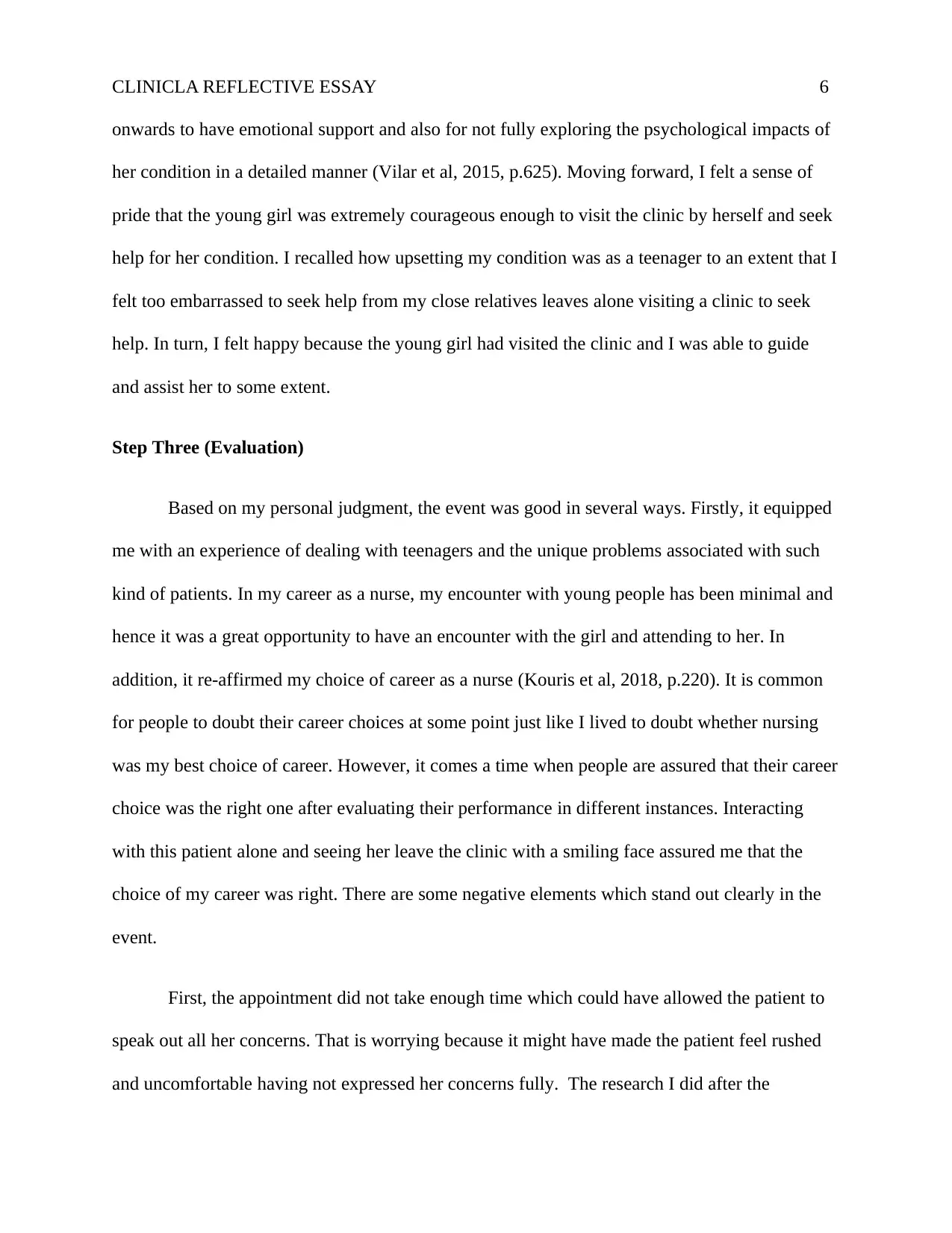
CLINICLA REFLECTIVE ESSAY 6
onwards to have emotional support and also for not fully exploring the psychological impacts of
her condition in a detailed manner (Vilar et al, 2015, p.625). Moving forward, I felt a sense of
pride that the young girl was extremely courageous enough to visit the clinic by herself and seek
help for her condition. I recalled how upsetting my condition was as a teenager to an extent that I
felt too embarrassed to seek help from my close relatives leaves alone visiting a clinic to seek
help. In turn, I felt happy because the young girl had visited the clinic and I was able to guide
and assist her to some extent.
Step Three (Evaluation)
Based on my personal judgment, the event was good in several ways. Firstly, it equipped
me with an experience of dealing with teenagers and the unique problems associated with such
kind of patients. In my career as a nurse, my encounter with young people has been minimal and
hence it was a great opportunity to have an encounter with the girl and attending to her. In
addition, it re-affirmed my choice of career as a nurse (Kouris et al, 2018, p.220). It is common
for people to doubt their career choices at some point just like I lived to doubt whether nursing
was my best choice of career. However, it comes a time when people are assured that their career
choice was the right one after evaluating their performance in different instances. Interacting
with this patient alone and seeing her leave the clinic with a smiling face assured me that the
choice of my career was right. There are some negative elements which stand out clearly in the
event.
First, the appointment did not take enough time which could have allowed the patient to
speak out all her concerns. That is worrying because it might have made the patient feel rushed
and uncomfortable having not expressed her concerns fully. The research I did after the
onwards to have emotional support and also for not fully exploring the psychological impacts of
her condition in a detailed manner (Vilar et al, 2015, p.625). Moving forward, I felt a sense of
pride that the young girl was extremely courageous enough to visit the clinic by herself and seek
help for her condition. I recalled how upsetting my condition was as a teenager to an extent that I
felt too embarrassed to seek help from my close relatives leaves alone visiting a clinic to seek
help. In turn, I felt happy because the young girl had visited the clinic and I was able to guide
and assist her to some extent.
Step Three (Evaluation)
Based on my personal judgment, the event was good in several ways. Firstly, it equipped
me with an experience of dealing with teenagers and the unique problems associated with such
kind of patients. In my career as a nurse, my encounter with young people has been minimal and
hence it was a great opportunity to have an encounter with the girl and attending to her. In
addition, it re-affirmed my choice of career as a nurse (Kouris et al, 2018, p.220). It is common
for people to doubt their career choices at some point just like I lived to doubt whether nursing
was my best choice of career. However, it comes a time when people are assured that their career
choice was the right one after evaluating their performance in different instances. Interacting
with this patient alone and seeing her leave the clinic with a smiling face assured me that the
choice of my career was right. There are some negative elements which stand out clearly in the
event.
First, the appointment did not take enough time which could have allowed the patient to
speak out all her concerns. That is worrying because it might have made the patient feel rushed
and uncomfortable having not expressed her concerns fully. The research I did after the
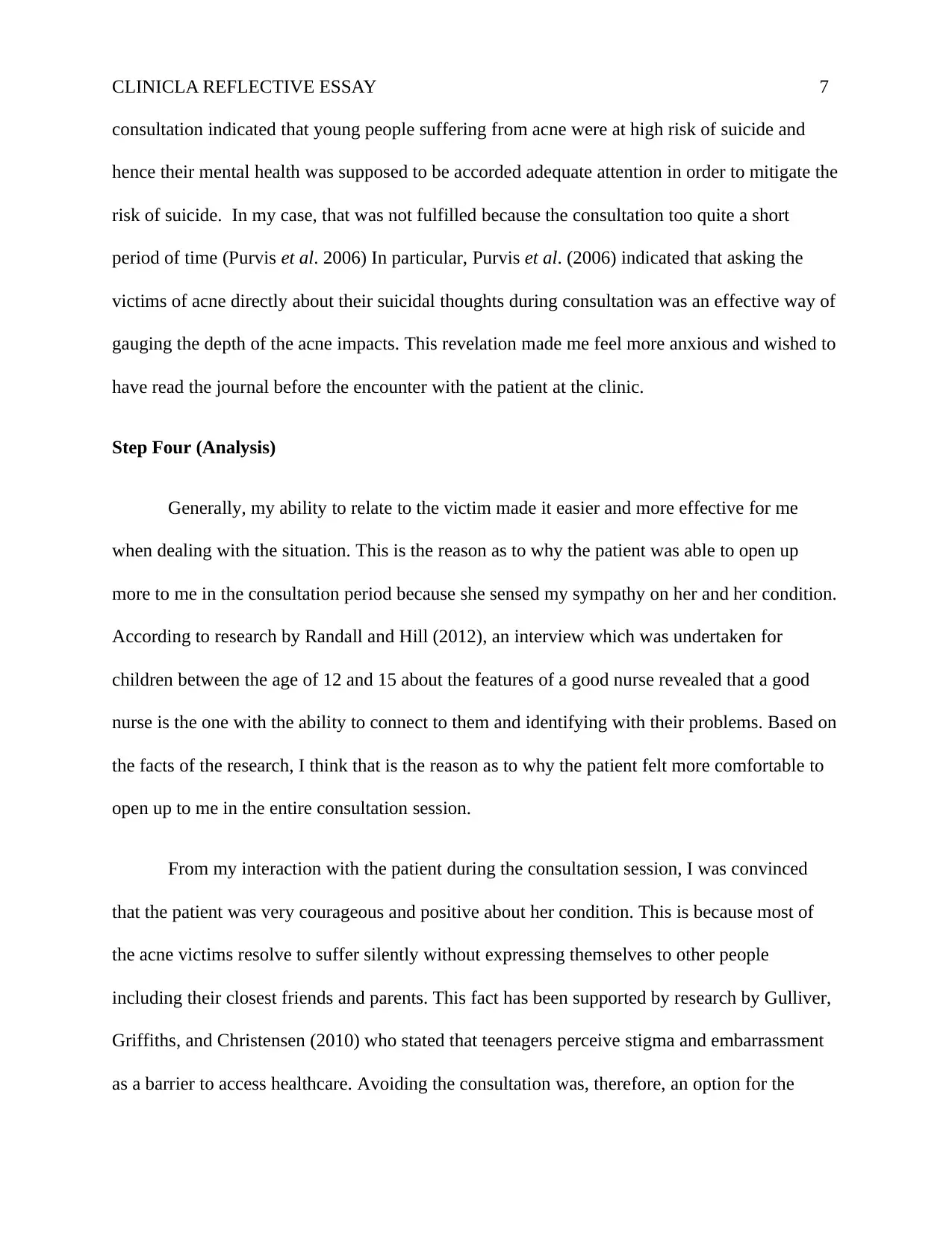
CLINICLA REFLECTIVE ESSAY 7
consultation indicated that young people suffering from acne were at high risk of suicide and
hence their mental health was supposed to be accorded adequate attention in order to mitigate the
risk of suicide. In my case, that was not fulfilled because the consultation too quite a short
period of time (Purvis et al. 2006) In particular, Purvis et al. (2006) indicated that asking the
victims of acne directly about their suicidal thoughts during consultation was an effective way of
gauging the depth of the acne impacts. This revelation made me feel more anxious and wished to
have read the journal before the encounter with the patient at the clinic.
Step Four (Analysis)
Generally, my ability to relate to the victim made it easier and more effective for me
when dealing with the situation. This is the reason as to why the patient was able to open up
more to me in the consultation period because she sensed my sympathy on her and her condition.
According to research by Randall and Hill (2012), an interview which was undertaken for
children between the age of 12 and 15 about the features of a good nurse revealed that a good
nurse is the one with the ability to connect to them and identifying with their problems. Based on
the facts of the research, I think that is the reason as to why the patient felt more comfortable to
open up to me in the entire consultation session.
From my interaction with the patient during the consultation session, I was convinced
that the patient was very courageous and positive about her condition. This is because most of
the acne victims resolve to suffer silently without expressing themselves to other people
including their closest friends and parents. This fact has been supported by research by Gulliver,
Griffiths, and Christensen (2010) who stated that teenagers perceive stigma and embarrassment
as a barrier to access healthcare. Avoiding the consultation was, therefore, an option for the
consultation indicated that young people suffering from acne were at high risk of suicide and
hence their mental health was supposed to be accorded adequate attention in order to mitigate the
risk of suicide. In my case, that was not fulfilled because the consultation too quite a short
period of time (Purvis et al. 2006) In particular, Purvis et al. (2006) indicated that asking the
victims of acne directly about their suicidal thoughts during consultation was an effective way of
gauging the depth of the acne impacts. This revelation made me feel more anxious and wished to
have read the journal before the encounter with the patient at the clinic.
Step Four (Analysis)
Generally, my ability to relate to the victim made it easier and more effective for me
when dealing with the situation. This is the reason as to why the patient was able to open up
more to me in the consultation period because she sensed my sympathy on her and her condition.
According to research by Randall and Hill (2012), an interview which was undertaken for
children between the age of 12 and 15 about the features of a good nurse revealed that a good
nurse is the one with the ability to connect to them and identifying with their problems. Based on
the facts of the research, I think that is the reason as to why the patient felt more comfortable to
open up to me in the entire consultation session.
From my interaction with the patient during the consultation session, I was convinced
that the patient was very courageous and positive about her condition. This is because most of
the acne victims resolve to suffer silently without expressing themselves to other people
including their closest friends and parents. This fact has been supported by research by Gulliver,
Griffiths, and Christensen (2010) who stated that teenagers perceive stigma and embarrassment
as a barrier to access healthcare. Avoiding the consultation was, therefore, an option for the
Paraphrase This Document
Need a fresh take? Get an instant paraphrase of this document with our AI Paraphraser
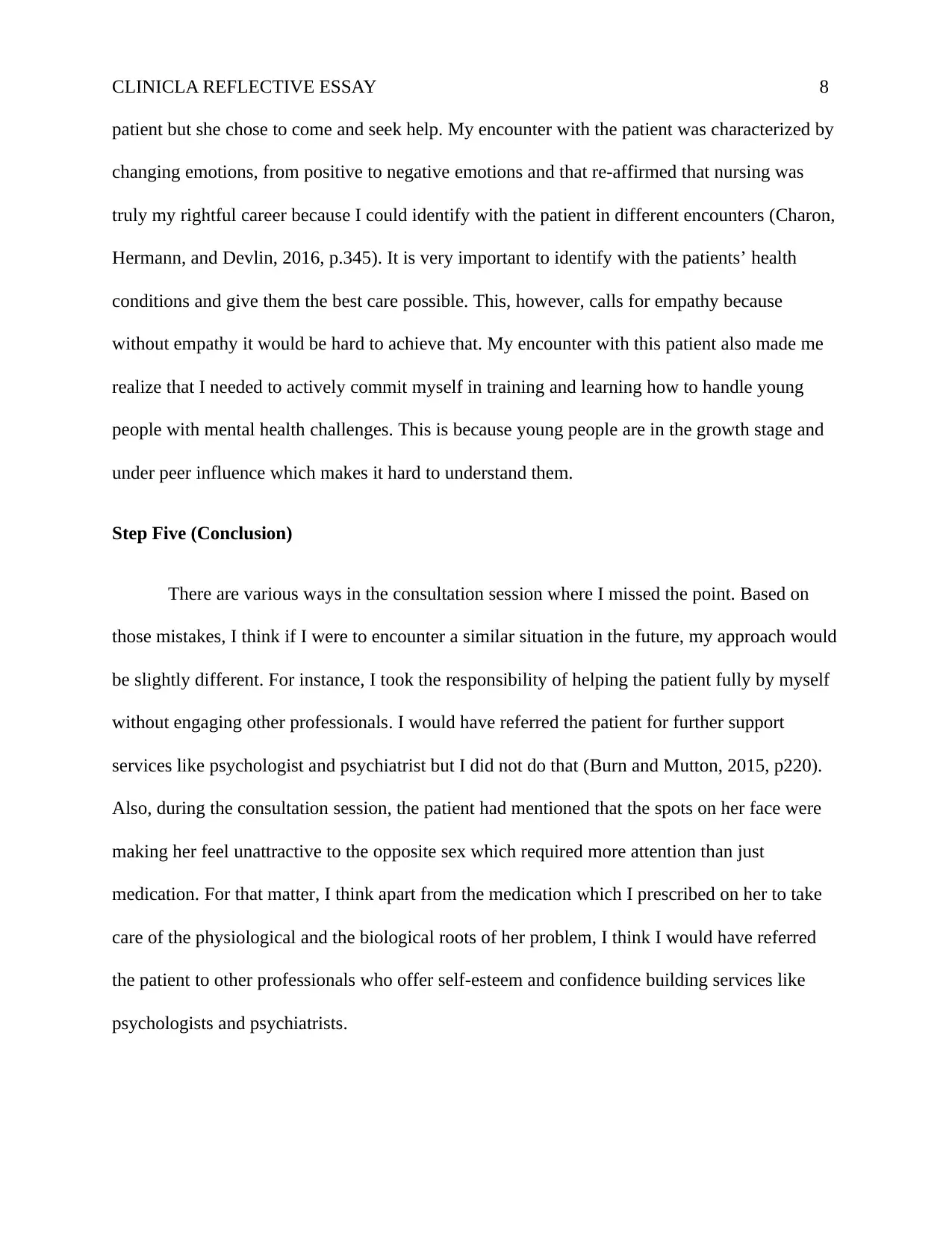
CLINICLA REFLECTIVE ESSAY 8
patient but she chose to come and seek help. My encounter with the patient was characterized by
changing emotions, from positive to negative emotions and that re-affirmed that nursing was
truly my rightful career because I could identify with the patient in different encounters (Charon,
Hermann, and Devlin, 2016, p.345). It is very important to identify with the patients’ health
conditions and give them the best care possible. This, however, calls for empathy because
without empathy it would be hard to achieve that. My encounter with this patient also made me
realize that I needed to actively commit myself in training and learning how to handle young
people with mental health challenges. This is because young people are in the growth stage and
under peer influence which makes it hard to understand them.
Step Five (Conclusion)
There are various ways in the consultation session where I missed the point. Based on
those mistakes, I think if I were to encounter a similar situation in the future, my approach would
be slightly different. For instance, I took the responsibility of helping the patient fully by myself
without engaging other professionals. I would have referred the patient for further support
services like psychologist and psychiatrist but I did not do that (Burn and Mutton, 2015, p220).
Also, during the consultation session, the patient had mentioned that the spots on her face were
making her feel unattractive to the opposite sex which required more attention than just
medication. For that matter, I think apart from the medication which I prescribed on her to take
care of the physiological and the biological roots of her problem, I think I would have referred
the patient to other professionals who offer self-esteem and confidence building services like
psychologists and psychiatrists.
patient but she chose to come and seek help. My encounter with the patient was characterized by
changing emotions, from positive to negative emotions and that re-affirmed that nursing was
truly my rightful career because I could identify with the patient in different encounters (Charon,
Hermann, and Devlin, 2016, p.345). It is very important to identify with the patients’ health
conditions and give them the best care possible. This, however, calls for empathy because
without empathy it would be hard to achieve that. My encounter with this patient also made me
realize that I needed to actively commit myself in training and learning how to handle young
people with mental health challenges. This is because young people are in the growth stage and
under peer influence which makes it hard to understand them.
Step Five (Conclusion)
There are various ways in the consultation session where I missed the point. Based on
those mistakes, I think if I were to encounter a similar situation in the future, my approach would
be slightly different. For instance, I took the responsibility of helping the patient fully by myself
without engaging other professionals. I would have referred the patient for further support
services like psychologist and psychiatrist but I did not do that (Burn and Mutton, 2015, p220).
Also, during the consultation session, the patient had mentioned that the spots on her face were
making her feel unattractive to the opposite sex which required more attention than just
medication. For that matter, I think apart from the medication which I prescribed on her to take
care of the physiological and the biological roots of her problem, I think I would have referred
the patient to other professionals who offer self-esteem and confidence building services like
psychologists and psychiatrists.
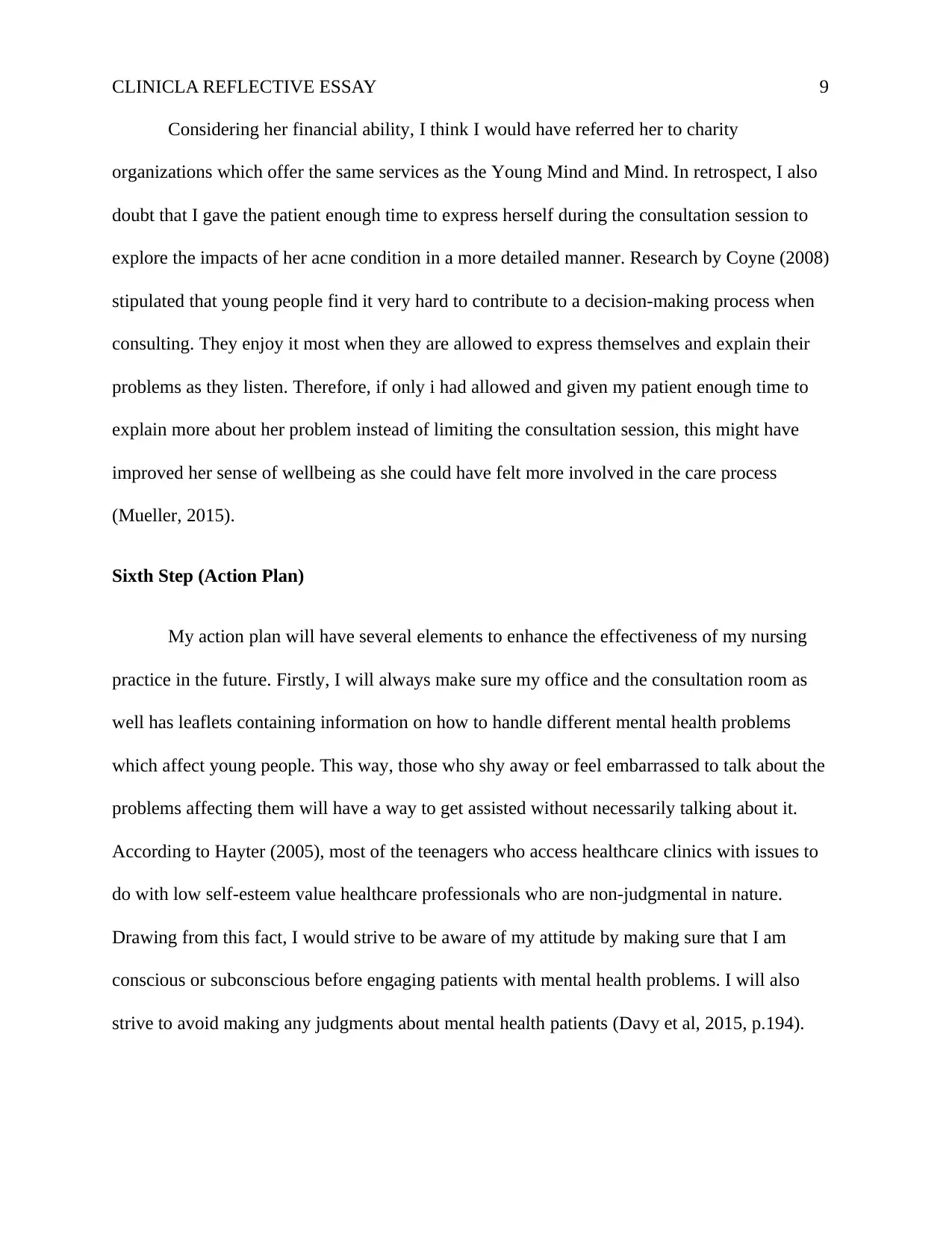
CLINICLA REFLECTIVE ESSAY 9
Considering her financial ability, I think I would have referred her to charity
organizations which offer the same services as the Young Mind and Mind. In retrospect, I also
doubt that I gave the patient enough time to express herself during the consultation session to
explore the impacts of her acne condition in a more detailed manner. Research by Coyne (2008)
stipulated that young people find it very hard to contribute to a decision-making process when
consulting. They enjoy it most when they are allowed to express themselves and explain their
problems as they listen. Therefore, if only i had allowed and given my patient enough time to
explain more about her problem instead of limiting the consultation session, this might have
improved her sense of wellbeing as she could have felt more involved in the care process
(Mueller, 2015).
Sixth Step (Action Plan)
My action plan will have several elements to enhance the effectiveness of my nursing
practice in the future. Firstly, I will always make sure my office and the consultation room as
well has leaflets containing information on how to handle different mental health problems
which affect young people. This way, those who shy away or feel embarrassed to talk about the
problems affecting them will have a way to get assisted without necessarily talking about it.
According to Hayter (2005), most of the teenagers who access healthcare clinics with issues to
do with low self-esteem value healthcare professionals who are non-judgmental in nature.
Drawing from this fact, I would strive to be aware of my attitude by making sure that I am
conscious or subconscious before engaging patients with mental health problems. I will also
strive to avoid making any judgments about mental health patients (Davy et al, 2015, p.194).
Considering her financial ability, I think I would have referred her to charity
organizations which offer the same services as the Young Mind and Mind. In retrospect, I also
doubt that I gave the patient enough time to express herself during the consultation session to
explore the impacts of her acne condition in a more detailed manner. Research by Coyne (2008)
stipulated that young people find it very hard to contribute to a decision-making process when
consulting. They enjoy it most when they are allowed to express themselves and explain their
problems as they listen. Therefore, if only i had allowed and given my patient enough time to
explain more about her problem instead of limiting the consultation session, this might have
improved her sense of wellbeing as she could have felt more involved in the care process
(Mueller, 2015).
Sixth Step (Action Plan)
My action plan will have several elements to enhance the effectiveness of my nursing
practice in the future. Firstly, I will always make sure my office and the consultation room as
well has leaflets containing information on how to handle different mental health problems
which affect young people. This way, those who shy away or feel embarrassed to talk about the
problems affecting them will have a way to get assisted without necessarily talking about it.
According to Hayter (2005), most of the teenagers who access healthcare clinics with issues to
do with low self-esteem value healthcare professionals who are non-judgmental in nature.
Drawing from this fact, I would strive to be aware of my attitude by making sure that I am
conscious or subconscious before engaging patients with mental health problems. I will also
strive to avoid making any judgments about mental health patients (Davy et al, 2015, p.194).
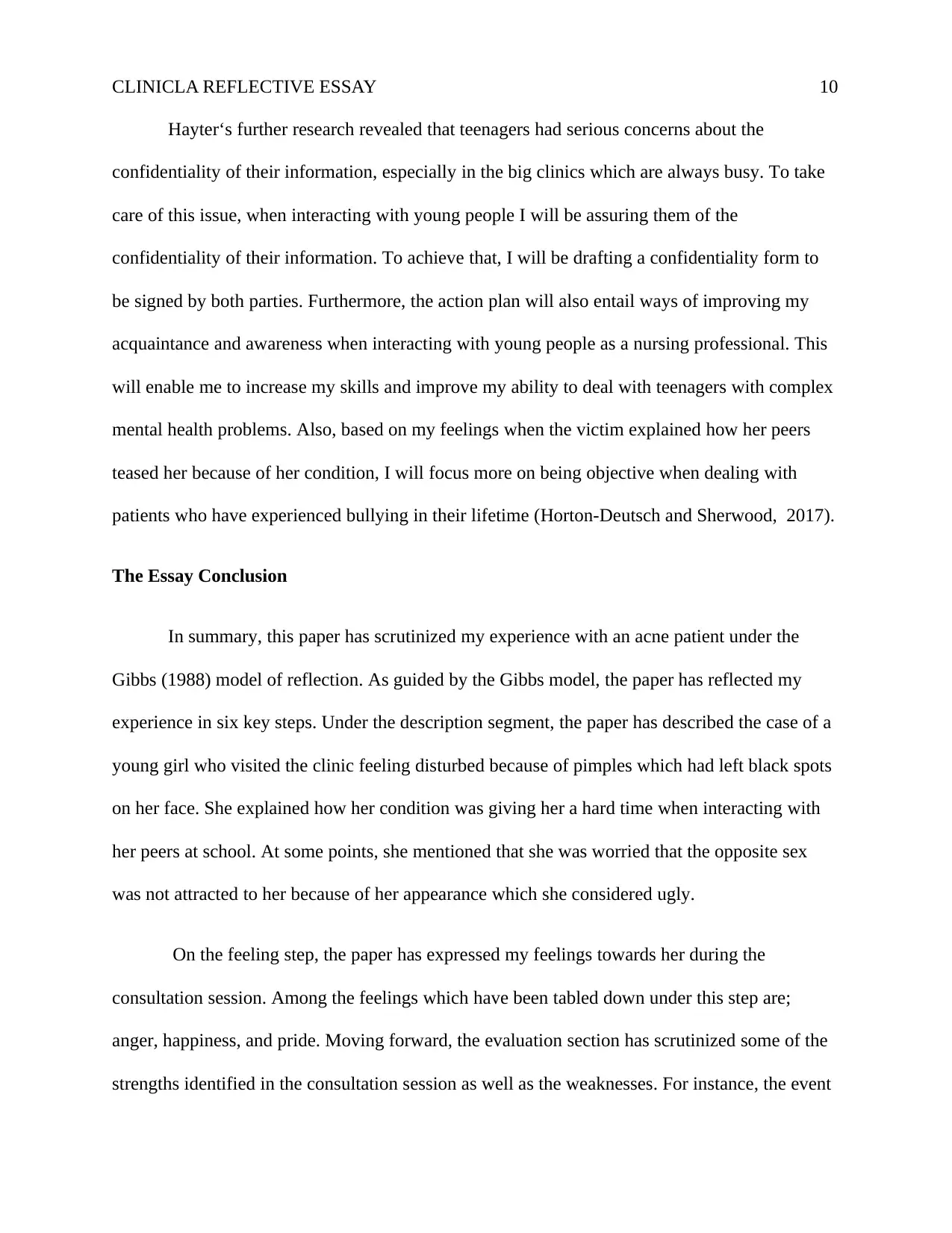
CLINICLA REFLECTIVE ESSAY 10
Hayter‘s further research revealed that teenagers had serious concerns about the
confidentiality of their information, especially in the big clinics which are always busy. To take
care of this issue, when interacting with young people I will be assuring them of the
confidentiality of their information. To achieve that, I will be drafting a confidentiality form to
be signed by both parties. Furthermore, the action plan will also entail ways of improving my
acquaintance and awareness when interacting with young people as a nursing professional. This
will enable me to increase my skills and improve my ability to deal with teenagers with complex
mental health problems. Also, based on my feelings when the victim explained how her peers
teased her because of her condition, I will focus more on being objective when dealing with
patients who have experienced bullying in their lifetime (Horton-Deutsch and Sherwood, 2017).
The Essay Conclusion
In summary, this paper has scrutinized my experience with an acne patient under the
Gibbs (1988) model of reflection. As guided by the Gibbs model, the paper has reflected my
experience in six key steps. Under the description segment, the paper has described the case of a
young girl who visited the clinic feeling disturbed because of pimples which had left black spots
on her face. She explained how her condition was giving her a hard time when interacting with
her peers at school. At some points, she mentioned that she was worried that the opposite sex
was not attracted to her because of her appearance which she considered ugly.
On the feeling step, the paper has expressed my feelings towards her during the
consultation session. Among the feelings which have been tabled down under this step are;
anger, happiness, and pride. Moving forward, the evaluation section has scrutinized some of the
strengths identified in the consultation session as well as the weaknesses. For instance, the event
Hayter‘s further research revealed that teenagers had serious concerns about the
confidentiality of their information, especially in the big clinics which are always busy. To take
care of this issue, when interacting with young people I will be assuring them of the
confidentiality of their information. To achieve that, I will be drafting a confidentiality form to
be signed by both parties. Furthermore, the action plan will also entail ways of improving my
acquaintance and awareness when interacting with young people as a nursing professional. This
will enable me to increase my skills and improve my ability to deal with teenagers with complex
mental health problems. Also, based on my feelings when the victim explained how her peers
teased her because of her condition, I will focus more on being objective when dealing with
patients who have experienced bullying in their lifetime (Horton-Deutsch and Sherwood, 2017).
The Essay Conclusion
In summary, this paper has scrutinized my experience with an acne patient under the
Gibbs (1988) model of reflection. As guided by the Gibbs model, the paper has reflected my
experience in six key steps. Under the description segment, the paper has described the case of a
young girl who visited the clinic feeling disturbed because of pimples which had left black spots
on her face. She explained how her condition was giving her a hard time when interacting with
her peers at school. At some points, she mentioned that she was worried that the opposite sex
was not attracted to her because of her appearance which she considered ugly.
On the feeling step, the paper has expressed my feelings towards her during the
consultation session. Among the feelings which have been tabled down under this step are;
anger, happiness, and pride. Moving forward, the evaluation section has scrutinized some of the
strengths identified in the consultation session as well as the weaknesses. For instance, the event
Secure Best Marks with AI Grader
Need help grading? Try our AI Grader for instant feedback on your assignments.
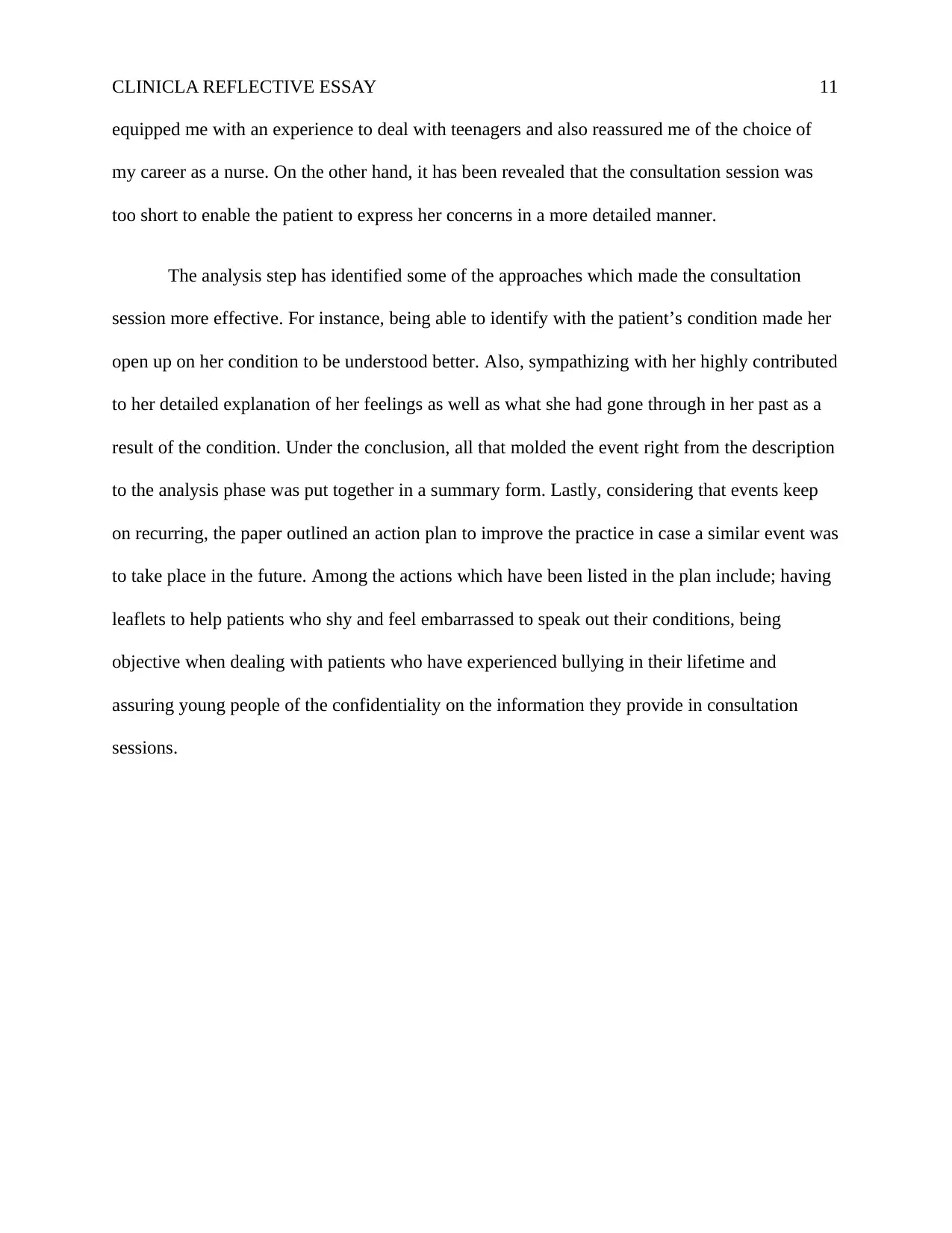
CLINICLA REFLECTIVE ESSAY 11
equipped me with an experience to deal with teenagers and also reassured me of the choice of
my career as a nurse. On the other hand, it has been revealed that the consultation session was
too short to enable the patient to express her concerns in a more detailed manner.
The analysis step has identified some of the approaches which made the consultation
session more effective. For instance, being able to identify with the patient’s condition made her
open up on her condition to be understood better. Also, sympathizing with her highly contributed
to her detailed explanation of her feelings as well as what she had gone through in her past as a
result of the condition. Under the conclusion, all that molded the event right from the description
to the analysis phase was put together in a summary form. Lastly, considering that events keep
on recurring, the paper outlined an action plan to improve the practice in case a similar event was
to take place in the future. Among the actions which have been listed in the plan include; having
leaflets to help patients who shy and feel embarrassed to speak out their conditions, being
objective when dealing with patients who have experienced bullying in their lifetime and
assuring young people of the confidentiality on the information they provide in consultation
sessions.
equipped me with an experience to deal with teenagers and also reassured me of the choice of
my career as a nurse. On the other hand, it has been revealed that the consultation session was
too short to enable the patient to express her concerns in a more detailed manner.
The analysis step has identified some of the approaches which made the consultation
session more effective. For instance, being able to identify with the patient’s condition made her
open up on her condition to be understood better. Also, sympathizing with her highly contributed
to her detailed explanation of her feelings as well as what she had gone through in her past as a
result of the condition. Under the conclusion, all that molded the event right from the description
to the analysis phase was put together in a summary form. Lastly, considering that events keep
on recurring, the paper outlined an action plan to improve the practice in case a similar event was
to take place in the future. Among the actions which have been listed in the plan include; having
leaflets to help patients who shy and feel embarrassed to speak out their conditions, being
objective when dealing with patients who have experienced bullying in their lifetime and
assuring young people of the confidentiality on the information they provide in consultation
sessions.
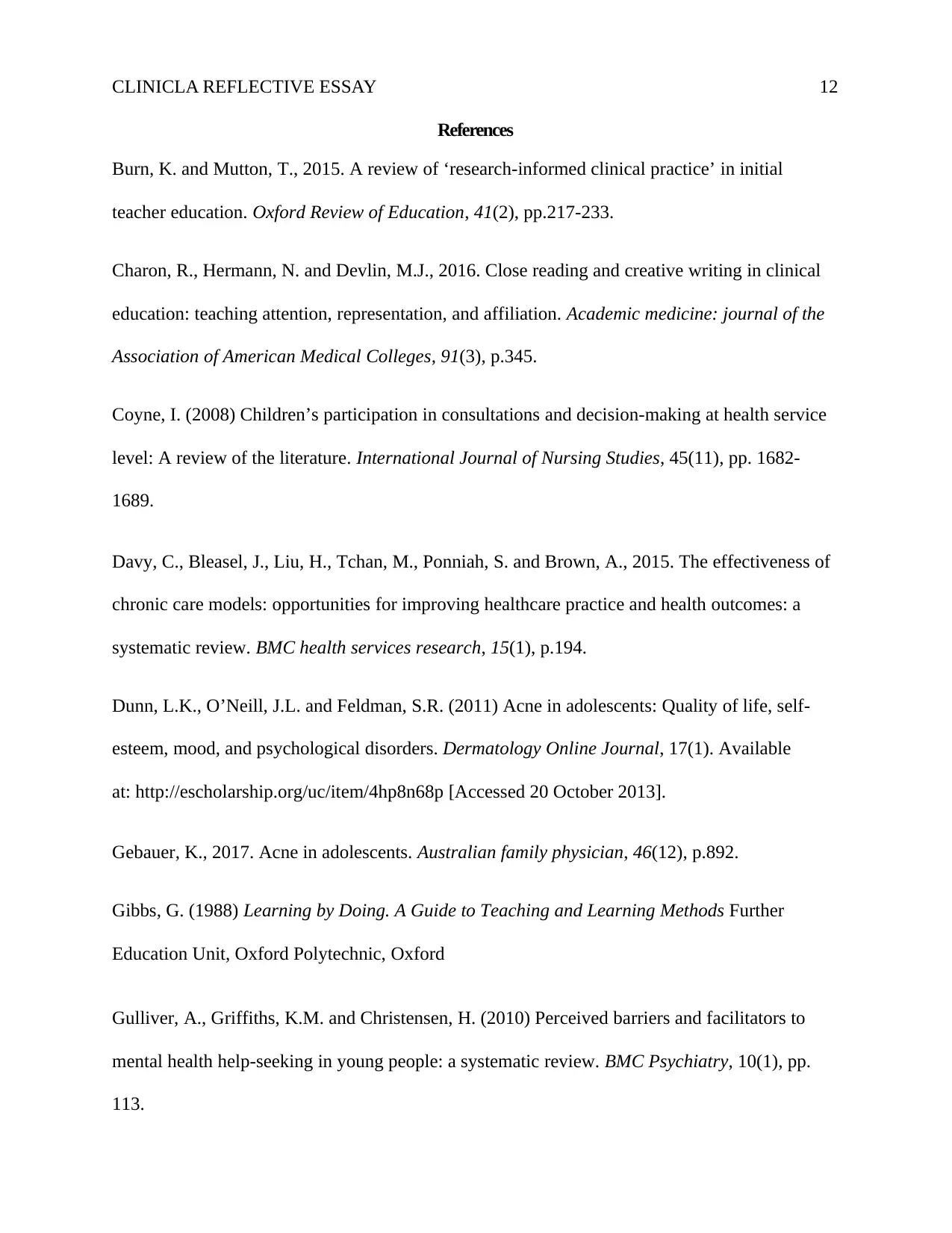
CLINICLA REFLECTIVE ESSAY 12
References
Burn, K. and Mutton, T., 2015. A review of ‘research-informed clinical practice’ in initial
teacher education. Oxford Review of Education, 41(2), pp.217-233.
Charon, R., Hermann, N. and Devlin, M.J., 2016. Close reading and creative writing in clinical
education: teaching attention, representation, and affiliation. Academic medicine: journal of the
Association of American Medical Colleges, 91(3), p.345.
Coyne, I. (2008) Children’s participation in consultations and decision-making at health service
level: A review of the literature. International Journal of Nursing Studies, 45(11), pp. 1682-
1689.
Davy, C., Bleasel, J., Liu, H., Tchan, M., Ponniah, S. and Brown, A., 2015. The effectiveness of
chronic care models: opportunities for improving healthcare practice and health outcomes: a
systematic review. BMC health services research, 15(1), p.194.
Dunn, L.K., O’Neill, J.L. and Feldman, S.R. (2011) Acne in adolescents: Quality of life, self-
esteem, mood, and psychological disorders. Dermatology Online Journal, 17(1). Available
at: http://escholarship.org/uc/item/4hp8n68p [Accessed 20 October 2013].
Gebauer, K., 2017. Acne in adolescents. Australian family physician, 46(12), p.892.
Gibbs, G. (1988) Learning by Doing. A Guide to Teaching and Learning Methods Further
Education Unit, Oxford Polytechnic, Oxford
Gulliver, A., Griffiths, K.M. and Christensen, H. (2010) Perceived barriers and facilitators to
mental health help-seeking in young people: a systematic review. BMC Psychiatry, 10(1), pp.
113.
References
Burn, K. and Mutton, T., 2015. A review of ‘research-informed clinical practice’ in initial
teacher education. Oxford Review of Education, 41(2), pp.217-233.
Charon, R., Hermann, N. and Devlin, M.J., 2016. Close reading and creative writing in clinical
education: teaching attention, representation, and affiliation. Academic medicine: journal of the
Association of American Medical Colleges, 91(3), p.345.
Coyne, I. (2008) Children’s participation in consultations and decision-making at health service
level: A review of the literature. International Journal of Nursing Studies, 45(11), pp. 1682-
1689.
Davy, C., Bleasel, J., Liu, H., Tchan, M., Ponniah, S. and Brown, A., 2015. The effectiveness of
chronic care models: opportunities for improving healthcare practice and health outcomes: a
systematic review. BMC health services research, 15(1), p.194.
Dunn, L.K., O’Neill, J.L. and Feldman, S.R. (2011) Acne in adolescents: Quality of life, self-
esteem, mood, and psychological disorders. Dermatology Online Journal, 17(1). Available
at: http://escholarship.org/uc/item/4hp8n68p [Accessed 20 October 2013].
Gebauer, K., 2017. Acne in adolescents. Australian family physician, 46(12), p.892.
Gibbs, G. (1988) Learning by Doing. A Guide to Teaching and Learning Methods Further
Education Unit, Oxford Polytechnic, Oxford
Gulliver, A., Griffiths, K.M. and Christensen, H. (2010) Perceived barriers and facilitators to
mental health help-seeking in young people: a systematic review. BMC Psychiatry, 10(1), pp.
113.
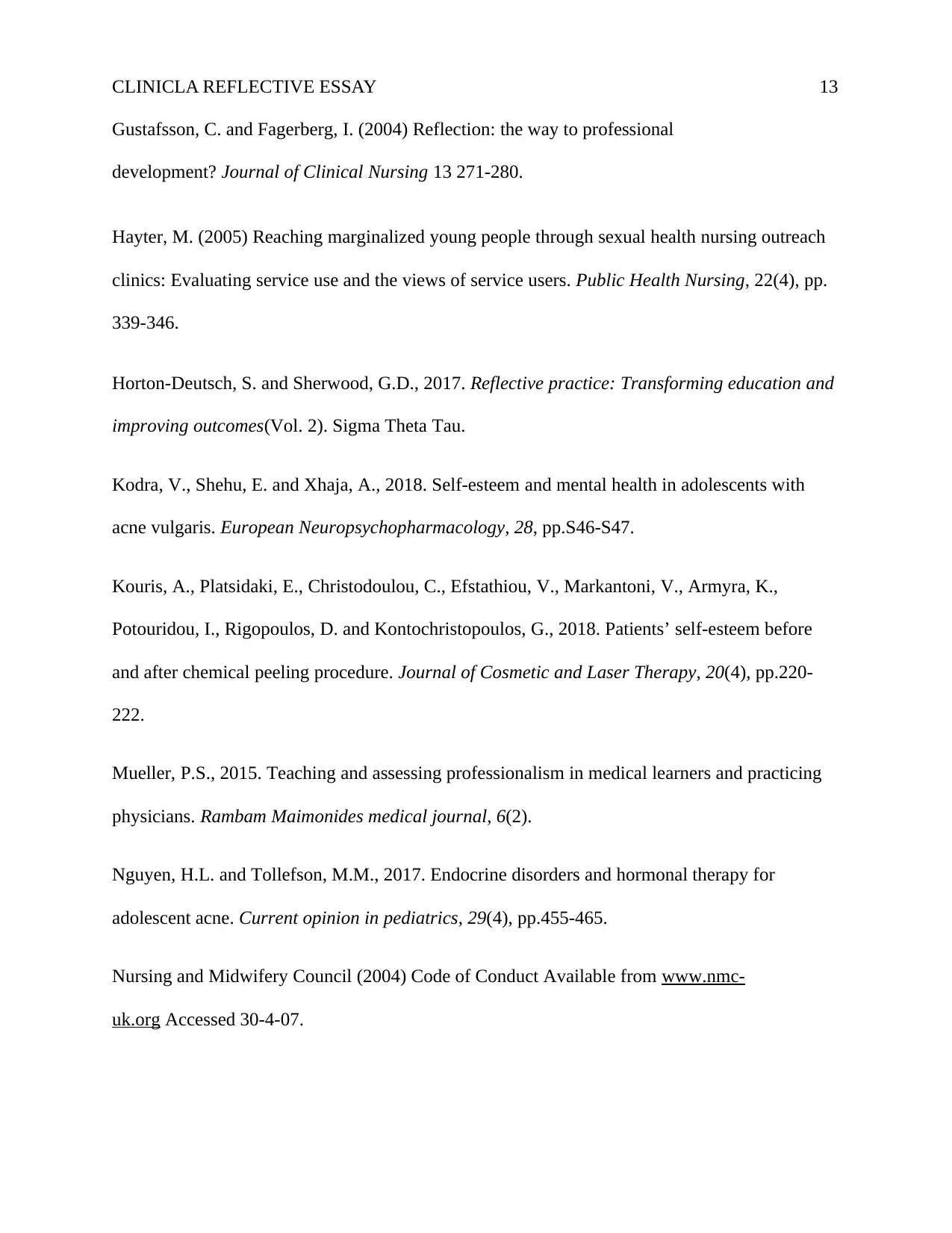
CLINICLA REFLECTIVE ESSAY 13
Gustafsson, C. and Fagerberg, I. (2004) Reflection: the way to professional
development? Journal of Clinical Nursing 13 271-280.
Hayter, M. (2005) Reaching marginalized young people through sexual health nursing outreach
clinics: Evaluating service use and the views of service users. Public Health Nursing, 22(4), pp.
339-346.
Horton-Deutsch, S. and Sherwood, G.D., 2017. Reflective practice: Transforming education and
improving outcomes(Vol. 2). Sigma Theta Tau.
Kodra, V., Shehu, E. and Xhaja, A., 2018. Self-esteem and mental health in adolescents with
acne vulgaris. European Neuropsychopharmacology, 28, pp.S46-S47.
Kouris, A., Platsidaki, E., Christodoulou, C., Efstathiou, V., Markantoni, V., Armyra, K.,
Potouridou, I., Rigopoulos, D. and Kontochristopoulos, G., 2018. Patients’ self-esteem before
and after chemical peeling procedure. Journal of Cosmetic and Laser Therapy, 20(4), pp.220-
222.
Mueller, P.S., 2015. Teaching and assessing professionalism in medical learners and practicing
physicians. Rambam Maimonides medical journal, 6(2).
Nguyen, H.L. and Tollefson, M.M., 2017. Endocrine disorders and hormonal therapy for
adolescent acne. Current opinion in pediatrics, 29(4), pp.455-465.
Nursing and Midwifery Council (2004) Code of Conduct Available from www.nmc-
uk.org Accessed 30-4-07.
Gustafsson, C. and Fagerberg, I. (2004) Reflection: the way to professional
development? Journal of Clinical Nursing 13 271-280.
Hayter, M. (2005) Reaching marginalized young people through sexual health nursing outreach
clinics: Evaluating service use and the views of service users. Public Health Nursing, 22(4), pp.
339-346.
Horton-Deutsch, S. and Sherwood, G.D., 2017. Reflective practice: Transforming education and
improving outcomes(Vol. 2). Sigma Theta Tau.
Kodra, V., Shehu, E. and Xhaja, A., 2018. Self-esteem and mental health in adolescents with
acne vulgaris. European Neuropsychopharmacology, 28, pp.S46-S47.
Kouris, A., Platsidaki, E., Christodoulou, C., Efstathiou, V., Markantoni, V., Armyra, K.,
Potouridou, I., Rigopoulos, D. and Kontochristopoulos, G., 2018. Patients’ self-esteem before
and after chemical peeling procedure. Journal of Cosmetic and Laser Therapy, 20(4), pp.220-
222.
Mueller, P.S., 2015. Teaching and assessing professionalism in medical learners and practicing
physicians. Rambam Maimonides medical journal, 6(2).
Nguyen, H.L. and Tollefson, M.M., 2017. Endocrine disorders and hormonal therapy for
adolescent acne. Current opinion in pediatrics, 29(4), pp.455-465.
Nursing and Midwifery Council (2004) Code of Conduct Available from www.nmc-
uk.org Accessed 30-4-07.
Paraphrase This Document
Need a fresh take? Get an instant paraphrase of this document with our AI Paraphraser
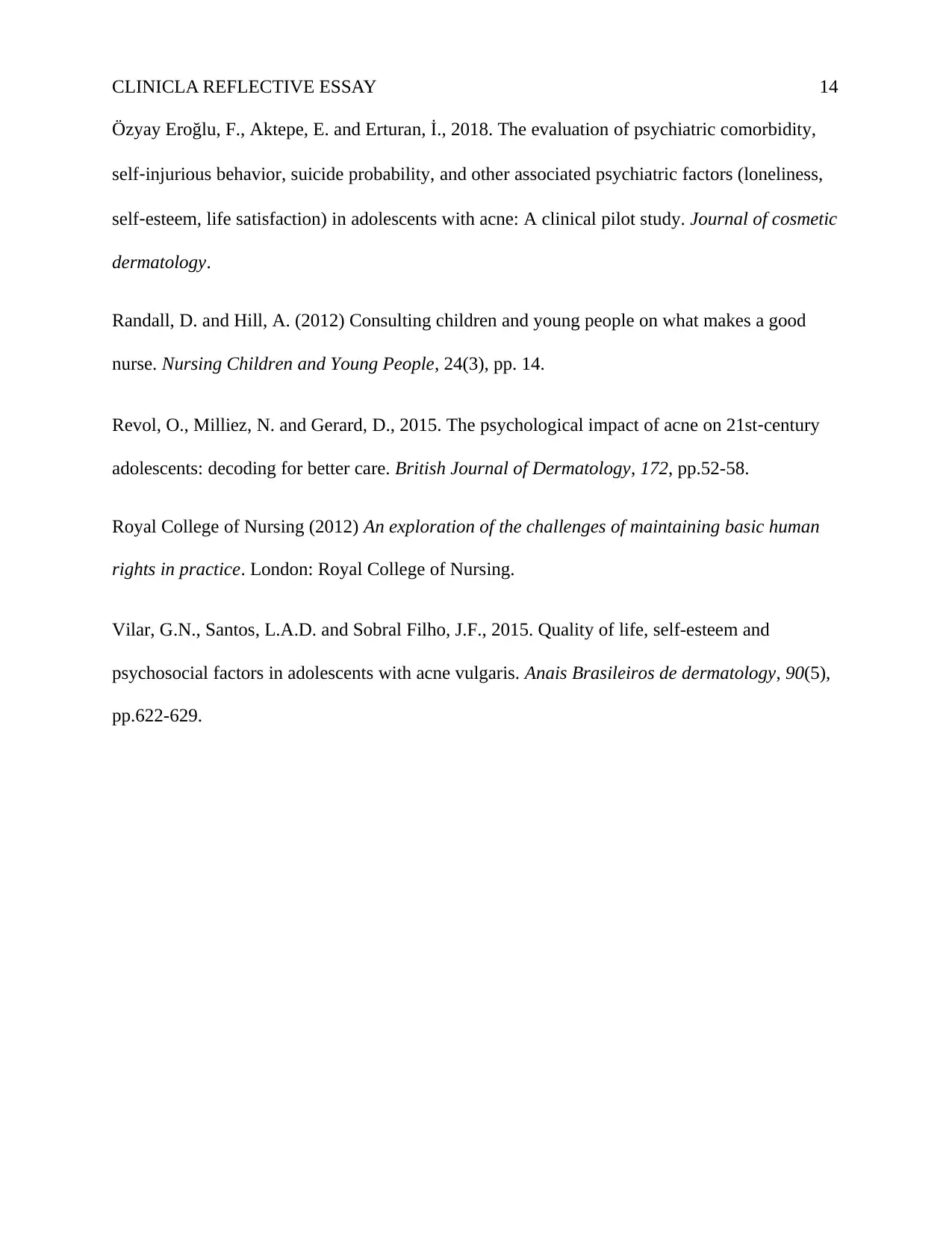
CLINICLA REFLECTIVE ESSAY 14
Özyay Eroğlu, F., Aktepe, E. and Erturan, İ., 2018. The evaluation of psychiatric comorbidity,
self‐injurious behavior, suicide probability, and other associated psychiatric factors (loneliness,
self‐esteem, life satisfaction) in adolescents with acne: A clinical pilot study. Journal of cosmetic
dermatology.
Randall, D. and Hill, A. (2012) Consulting children and young people on what makes a good
nurse. Nursing Children and Young People, 24(3), pp. 14.
Revol, O., Milliez, N. and Gerard, D., 2015. The psychological impact of acne on 21st‐century
adolescents: decoding for better care. British Journal of Dermatology, 172, pp.52-58.
Royal College of Nursing (2012) An exploration of the challenges of maintaining basic human
rights in practice. London: Royal College of Nursing.
Vilar, G.N., Santos, L.A.D. and Sobral Filho, J.F., 2015. Quality of life, self-esteem and
psychosocial factors in adolescents with acne vulgaris. Anais Brasileiros de dermatology, 90(5),
pp.622-629.
Özyay Eroğlu, F., Aktepe, E. and Erturan, İ., 2018. The evaluation of psychiatric comorbidity,
self‐injurious behavior, suicide probability, and other associated psychiatric factors (loneliness,
self‐esteem, life satisfaction) in adolescents with acne: A clinical pilot study. Journal of cosmetic
dermatology.
Randall, D. and Hill, A. (2012) Consulting children and young people on what makes a good
nurse. Nursing Children and Young People, 24(3), pp. 14.
Revol, O., Milliez, N. and Gerard, D., 2015. The psychological impact of acne on 21st‐century
adolescents: decoding for better care. British Journal of Dermatology, 172, pp.52-58.
Royal College of Nursing (2012) An exploration of the challenges of maintaining basic human
rights in practice. London: Royal College of Nursing.
Vilar, G.N., Santos, L.A.D. and Sobral Filho, J.F., 2015. Quality of life, self-esteem and
psychosocial factors in adolescents with acne vulgaris. Anais Brasileiros de dermatology, 90(5),
pp.622-629.
1 out of 14
Related Documents
Your All-in-One AI-Powered Toolkit for Academic Success.
+13062052269
info@desklib.com
Available 24*7 on WhatsApp / Email
![[object Object]](/_next/static/media/star-bottom.7253800d.svg)
Unlock your academic potential
© 2024 | Zucol Services PVT LTD | All rights reserved.





